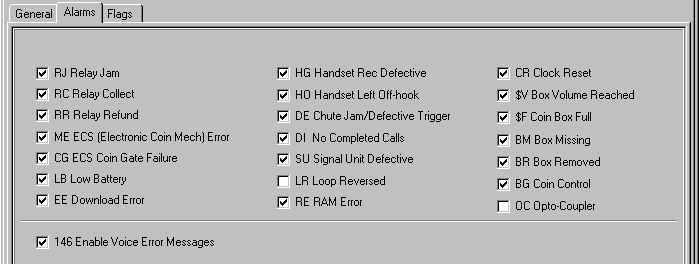Alarms
One of the advantages of using intelligent payphones is that they can diagnose themselves and submit
ìflagsî to the owner to indicate the status of important payphone functions. The Alarms tab lists all of the status flags that are high in importance. The flags include things like mechanical and electronic malfunctions, theft or vandalism detection, and coin-related needs.
To get to the Alarms tab, select
Options Records from the Configuration button in the Navigator or the Navbar to open the Options window. The Most Common tab is already selected when the Options window opens. Click on the Reporting & Polling tab, then click on the Alarms tab.

When a specific condition is met, a flag is triggered that indicates that condition. If the flag
ís checkbox is checked (in the Reporting & Polling tab of the Options window), then the phone will report the flag to the computer two-minutes after the flag is set. If the report is unsuccessful, the phone will try to report again in 2 hours, then again in 4 hours, then every 8 hours until the report is successful or until the phone is successfully polled. If the flag is not checked, then the phone will not report to the computer, but will still upload the set flag the next time the payphone is polled. Exceptions to this are noted when necessary. Following is a list of the two-letter alarm codes and a short definition of what each one means:
146
ñ Enable Voice Error Messages: When checked, the phone will give voice error messages that are equivalent to the alarms and flags. After each alarm description the voice code is listed.
Note: After some of the alarm descriptions, two numbers are listed. These are the voice error messages given when option 146, detailed above, is checked. At the bottom is a table for quick reference.
$F
ñ Coin Box Full: The coin box volume has reached 100%. If the coin box is not emptied, a coin jam may result. 2, 1
$V
ñ Coin Box Volume Reached: The coin box has reached the volume set in the Preferences window. Empty the coin box. 0, 4
BG
ñ Coin Control (Bad Ground): The phone has made four unsuccessful attempts to detect either a collect or a refund signal from the central office, possibly indicating that the phone is not grounded properly. When a refund or collect signal is detected, the flag resets. 4, 4
BM
ñ Box Missing: The coin box has been missing from the phone for at least 15 minutes. 5, 5
BR
ñ Box Removed: The coin box was removed from the phone. 5, 1
CF
ñ Billable CDR Full: Indicates that there have been 52 store & forward calls made since the last time the CDR information was uploaded during a poll or report. Store & forward calls will not be allowed from the payphone until this information has been uploaded. To upload CDR information, make sure the checkbox Collect Audit CDR is checked in the Polling Actions window. 1, 7
CG
ñ ECS (Electronic Coin Scanner) Gate Failure: An error was detected from the collect/refund gate in the Electronic Coin Scanner II. This may be caused by a jam, a failure in the coin gate circuit, or tampering. Replace the ECS II.
CR
ñ Clock Reset: The date and time have been reset due to a power-on reset. The date and time are automatically set during a poll or report. 4, 5
DE
ñ Chute Jam/Defective Trigger: The payphone did not see deposited coins on 10 consecutive attempts to process a call. When a coin call is completed, this flag resets. 2, 3
DI
ñ No Completed Calls: The handset was taken off-hook a certain number of times without completing a single call. Specify the number of times necessary to trigger the flag in the Peg Count/Inactivity setting. Open the Options window, click the Reporting & Polling tab, and click the General tab. 5, 6
EE
ñ Download Error: The programming stored in EEPROM has corrupted. Replace the EEPROM chip(s). 4, 6
HG
ñ Handset Receiver Defective: The resistance in the handset circuit is not correct. The handset may be missing, defective, or improperly installed. 3, 7
HO
ñ Handset Left Off Hook: The handset was left off-hook for more than 15 minutes without activity. Check hookswitch operation. 3, 4
LB
ñ Low Battery: The payphoneís NiCad battery voltage is low and the battery has started charging. A recurring LB flag may indicate that the NiCad battery should be replaced, or that the line voltage or current is low. 3, 0
LR
ñ Loop reversed: The tip and ring wires are connected to the phone backwards. 0, 7
ME
ñ ECS (Electronic Coin Mechanism) Error: An Electronic Coin Scanner mechanism failure was detected. Check the ECS, the chassis, and the connection between them.
OC
ñ Opto-Coupler: There has been a collect/refund hardware failure in the payphone. 5, 0
RC
ñ Relay Collect: The escrow relay unsuccessfully tried to collect coins six times. There may be a coin jam or a relay malfunction. 5, 3
RE
ñ RAM Error: The RAM used to store cost and options data has shown an error. If, after polling the phone, the flag does not reset, the RAM on the chassis or the chassis itself must be repaired. 0, 5
RJ
ñ Relay Jam: The escrow relay was not able to perform the collect or refund function. There may be a coin jam or a relay malfunction. 0, 6
RR
ñ Relay Refund: The escrow relay unsuccessfully tried to refund coins six times. There may be a coin jam or a relay malfunction. 5, 2
SU
ñ Signal Unit Defective: The phone detected a coin when there was no coin present. Either the signal unit is bad or there is moisture in it.
Table for voice codes
ñ> alarms: